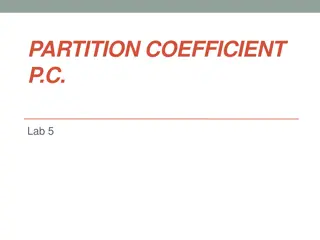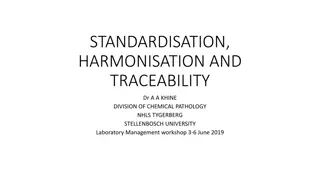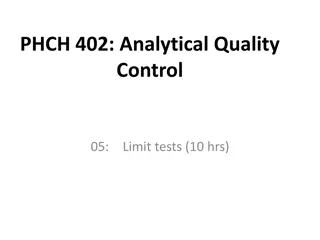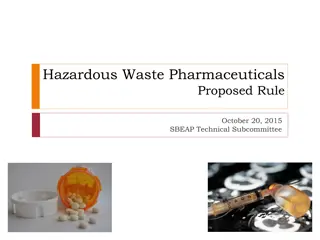Understanding Good Laboratory Practices (GLP) in Pharmaceuticals
Good Laboratory Practices (GLP) is a quality system ensuring non-clinical health and environmental safety studies are conducted accurately and reliably. GLP promotes the validity of test data for determining safety of chemicals, pharmaceuticals, food, and cosmetics. This article explores the definition, purpose, importance, and comparison with Good Manufacturing Practices (GMP). It also covers the general requirements outlined in Schedule-L1 for GLP compliance in laboratory settings.
Download Presentation

Please find below an Image/Link to download the presentation.
The content on the website is provided AS IS for your information and personal use only. It may not be sold, licensed, or shared on other websites without obtaining consent from the author. Download presentation by click this link. If you encounter any issues during the download, it is possible that the publisher has removed the file from their server.
E N D
Presentation Transcript
GOOD LABORATORY PRACTICES Sri. V.L.Hambar Deputy Drugs Controller, HQ, Drugs Control Dept. Bangalore
INTRODUCTION NUMBER MANUFACTURERS LABORATORY STUDIES ON SUCH PRODUCTS FOR THEIR PROPERTIES AND SAFETY AND TO SUBMIT THE RESULTS OF THESE STUDIES TO GOVERNMENT AUTHORITY/REGULATORY AUTHORITIES FOR THE ASSESSMENT OF POTENTIAL HAZARDS TO HUMAN HEALTH AND THE ENVIRONMENT AND HAVE PASSED LEGISLATION TO THAT EFFECT . OF COUNTRIES REQUIRE THE TO PERFORM
AMENDMENT Good Laboratory Practices has been made as law by introducing it as Schedule L-1 which is a New Schedule under Drugs and Cosmetics Rules, 1945 vide Gazette notification no GSR 780 (E) 10-11-2008 with effect from 1-11-2010. Consequent to this amendment, Rule 74, 78 and Rule 150E of the Drugs and Cosmetics Rules, 1945 have been amended. It involves a number of good practices in laboratory which are to be undertaken to carry out an analysis with a defined degree of Accuracy & Precision. the Quality Control
Definition of GLP Good Laboratory Practices(GLP) is a quality system concerned with the organizational process and the conditions under which non- clinical health and environmental safety studies are planned, performed, monitored, recorded, archived and reported.
The purpose of GLP The principle of Good laboratory practice (GLP) : to promote the development of quality and validity of test data used for determining the safety of chemicals, Pharmaceuticals, Food, Cosmetics etc.
Importance of G L P Since materials, intermediates and finished products are ultimately based on the generated in the Q.C. Laboratory, Accuracy, Precision and Reliability of these results are importance. raw materials, packaging released results analytical of paramount
GMP vs. GLP Laboratory Processes Results of Analysis Samples Good Laboratory Practices Raw Materials Packaging Materials Manufacturing Processes Finished Product of Standard Quality Good Manufacturing Practices
Schedule-L1 (GLP) General requirements Premises Personal Equipments Chemicals & Reagents Good House Keeping and Safety Maintenance , calibration, and validation of equipments Reference materials Microbiological cultures 10. Quality system 11. Internal quality system audits 12. Management review 13. Standard Operating Procedures 14. Protocols and Specifications archive 15. Raw data 16. Storage and archival 1. 2. 3. 4. 5. 6. 7. 8. 9.
Factors influencing implementation & maintenance of GLP in Q.C. laboratory Laboratory infrastructure. Reference Standards & reference microbial cultures. Quality of analytical Reagents & Chemicals. Quality of Volumetric glass wares. Preparation of Standard solutions and reagent solutions. Calibration of Equipments / instruments & volumetric glass wares. Validation of Analytical methods specially non-pharmacopoeial methods. Proper documentation of analytical methods, specifications & protocol of tests. Training of analysts: formal & informal Good Safety practices.
Laboratory Infrastructure General Chemical Laboratory The specific requirements are: Well ventilated, lighted and preferably air conditioned to maintain a temperature of 27 10C. Fitted with proper laboratory furnitures and fixtures . Instrument Room: The specific requirements are: Temperature : 25 10C Relative humidity : 45 5%. Constant supply of Electricity No vibrational disturbances. Separate room for housing semi-micro & microbalances.
Laboratory Infrastructure Microbial Laboratory: Air conditioned, preferably with AHU with suitable filter (5 micron or less). Fitted with proper laboratory furnitures & fixtures and a change room. For units having both sterile & non sterile products there should be two aseptic zones having class 1000 area with LAF and entry through graded air zones, one for inoculation and cultures transfer and another for sterility testing. For units having only non-sterile products, one aseptic zone shall be there.
Laboratory Infrastructure Hot Zone : For housing Hot Air Oven, Muffle Furnace, Fume Cupboard, Autoclaves etc. one Hot Zone is required. This zone should have proper ventilation system. Package Material Testing Section : The specific requirements are: Adequate space, Required equipments and instrument. Furnitures & Fixtures.
Laboratory Infrastructure Retained Sample Area : This is required retained samples of both finished products and active raw materials The specific requirements are: Proper temperature control (wherever required) Proper demarcation for finished products and active raw materials. Cleaning Area: The specific requirements are: Suitable size Provided with facilities like running hot and cold water, purified water, different cleaning agents apparatus. for storage & preservation of for glass
Laboratory Infrastructure Storage Area for Lab Chemicals, Glass Apparatus & Miscellaneous Items: There should be an adequate area with proper demarcation and proper temperature control wherever required for storage of laboratory chemicals, solvent, glass apparatus & miscellaneous items. In addition to these, there should be adequate arrangements for all types of services like vacuum, compressed air, nitrogen, potable water, purified water, ultra-pure water etc. in different sections of Q.C. Lab.
Reference Standard Primary reference Standards for active & inactive bulk drugs of IP, BPCRS, EPCRS, USP grade Reference standards for impurities wherever applicable and available Procurement Central Drugs Laboratory, Kolkata; United States IP Commission, Pharmacopoeia Convention (USPC) etc. from respective authorities like Proper Preservation (i.e. at controlled temperature and humidity etc.)
Reference Standard Development of suitable working Standard from available active raw materials with the help of these primary standards. Identification and Storage of working standards with expiry date, appropriate information. retest date and other Documentation of all information regarding these primary standards and working standards.
Reference Microbial Cultures Reference microbial cultures Procurement from Central Drugs Laboratory, Kolkata; National Collection of Type Culture (N.C.T.C.) U.K. and American Type Culture Collection (A.T.C.C.) U.S.A. wherever required. Proper Maintenance in the microbial lab as per respective pharmacopoeia. Proper documentation.
Analytical Reagents & Chemicals All analytical Reagents and Chemicals should be of analytical reagents manufacturer. These should comply with the specification for reagents given in different pharmacopoeia. The specification of the reagents required must be mentioned clearly in the test method. grades of suitable
Volumetric Glassware Two grades of volumetric glassware are used in the laboratory Class A: with test certificate, as per specification laid down by B.I.S. Class B as B.I.S. Class A are to be used for Work of the highest accuracy like standardization of volumetric solutions & Class B for routine work. Cleanliness of glassware should be ensured before use and periodic validation in this respect are to be done.
Preparation of Standard solutions and reagent All standard solutions (reference standards and volumetric Standards) and reagents solution must have proper labels indicating name, strength, date of preparation, date of expiry and storage documentation having details of preparation of these solution are to be maintained chronologically. conditions. Proper
Validation of Analytical Procedure All non Pharmacopoeial analytical methods having tests for identity, impurity / impurities & purity are to be validated properly before use in respect of 1. Accuracy 2. Precision 3. Specificity 4. Linearity and Range 5. Limit of Detection 6. Limit of Quantitation 7. Robustness and 8. Ruggedness (as applicable for each individual method). For detailed methods of validation ICH guidelines may be referred.
Calibration of Equipments and instruments Calibration is the comparison of the performance of a measuring equipment / instrument with that of standard equipment / instrument. In a Quality Control lab, all equipments and instruments which are directly or indirectly used for measurement are to be calibrated periodically.
Types of Calibration Calibration by external agency: 1. Some measuring equipments / instruments like pressure gauge, thermo dials, glass thermometers, wet and dry bulb hygrometers, balances etc. can be calibrated with the help of an NABL accredited external agency. 2. Calibration in the laboratory : Some Spectrophotometer, Polarimeter etc can be calibrated internally using methods described in pharmacopoeia. measuring instruments like UV VIS
Types of Calibration 3. Calibration in the laboratory with the help of external agency Certain instruments like HPLC, gas chromatograph, particle counters etc. are to be calibrated with the help of procedures described in the operating manual and/ or service manual of these instruments. 4. Calibration by Validation of the respective procedure: Some equipments/ instrument may be calibrated indirectly by validation of the respective procedure. For example: Monitoring of the autoclaving process in an autoclave with the help of Bacillus stearothermophyllus spore strip .
Training All laboratory personnel (managers, supervisory staffs, analysts, technicians, helpers and others) should have regular training and updation. Training can be of two types 1. Formal training : This may cover different topics like analytical chemistry, statistical techniques, microbial techniques, instrumental techniques, electronic data processing, documentation etc. 1. Informal training : Informal or on the job training involves laboratory skills . Records of training must be kept.
Documentation & Records Usual Document and records with which Q C Laboratory has to deal with are Specification Test Procedure Standard Operating Procedures Certificate of Analysis with relevant Test Protocols Sample Register Register for Reference Standards & Reference Cultures Calibration Records Validation Records Training Records Records for Retained samples (Both finished products & active raw materials) Records pertaining to the preparation of solutions of reference standards, volumetric solutions and other reagents. Log book for instruments & equipments. All documents are to be reviewed periodically and updated whenever required. Records should be maintained in such a manner that these are always traceable. If required help of electronic data processing system may be taken.
Safety In the Quality Control Laboratory, one has to handle a no of hazardous, poisonous and inflammable chemicals and also pathogenic organisms. Hence the adoption of proper safety measure and use of safety devices are of paramount importance. The use of mask, gloves, face shields, aprons, gumboots etc. should be made compulsory in the handling of corrosive chemicals. There should be arrangements in the laboratory and personnel should be given proper training for fire fighting. adequate fire fighting Training for other safety measures should be imparted regularly and records of these training should be maintained. Microbial residues should be regularly destroyed by autoclaving and records maintained.
A General Checklist for GLP Implementation (1)Good house-keeping, (2) Quality Manual/Documentation, (3) Quality Policy, (4) Method Validation, (5) Instrumental Validation, (6) System Suitability Tests, (7) Calibration of Equipments/Instruments/ Calibration Schedules/Traceability,
Checklist for GLP (8) Equipment Log Books, (9) Standard Analytical Reference Samples and their Traceability(All related Certificates/Documentation), (10) Archives for Samples and Documents, (11) Specifications for the products investigated, (12) Good Vendor Development, (13) Study Director for Projects, (14) Statistical Evaluations,
Checklist (15) Staff proficiency, Health and Safety, (16) Procedures for Receiving, Dealing and Disposing Samples, (17) Environmental monitoring in working areas, (18) Effluent Treatment Monitoring and Control,
Checklist (19) Participation in Proficiency Testing Programs, (20) Internal Audits/Checklists, (21) Management Review Meetings, (22) Official Audits/Surveillance Audits, (23) Customer Complaints Procedures to deal with them and Finding Solutions, (24) Validation of Computer Systems and Softwares, (25) Continuous Performance Assessment of QA Group, (26) Raw Data Collection/Traceability of Data
Checklist (27) Continuous upgradation of knowledge of all Personnel through Systematic Training Programs, (28) Material Safety Data Sheets Toxicity Informations, Antidotes for all Dangerous/Hazardous Chemicals, (29) First Aid Facilities, (30) Assignment of Clear and Unambiguous Responsibilities to Various Officers/Personnel,
Checklist (31) Standard Operating Procedures, (32) Sampling Procedures, A set of highly qualified, experienced, dedicated and motivated persons to carry out the GLP program. Even if all the other conditions are satisfied, the GLP program will meet with failure, if adequate and competent Human Resources are not available.
Gains Better results. Management assured through internal QA unit that the studies it manages are done to a certain standard. Very few studies are now repeated because of procedural problems. Studies are generally better protocolled/conducted/reported.
Gains All the data produced are now held in secure archives, facilitating its recovery for both internal use and when required by Regulatory bodies. Regular inspection/audits have ensured that companies maintain their standards at a high level.
Gains Studies done under GLP are definitely more acceptable to Regulatory bodies. Non GLP data are liable to get rejected.
Losses/Disadvantages Costs: Initially about 20% high. Later on 5%. Industry has lost some of its freedom. A more stereotyped approach to scientific work. Many scientists may leave testing as they dislike to work under such constraints.
Losses/Disadvantages Proliferation of documentation, though better organised and stored than ever before. The gains far outweigh the losses.
CONCLUSION In conclusion one must realize that in the pharmaceutical industry there is no margin for error and one must follow good practices in the laboratory to generate accurate, precise and reliable data.























